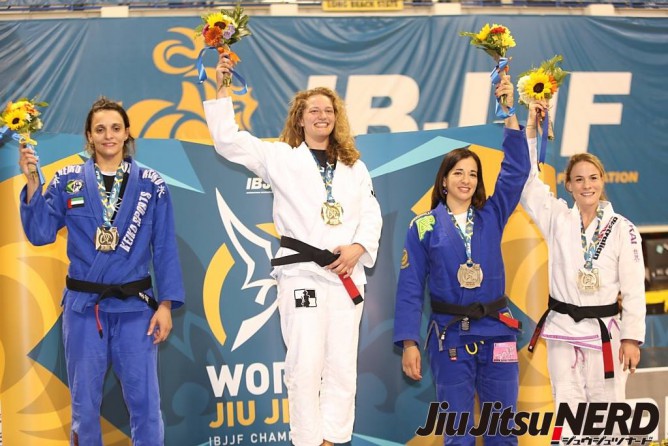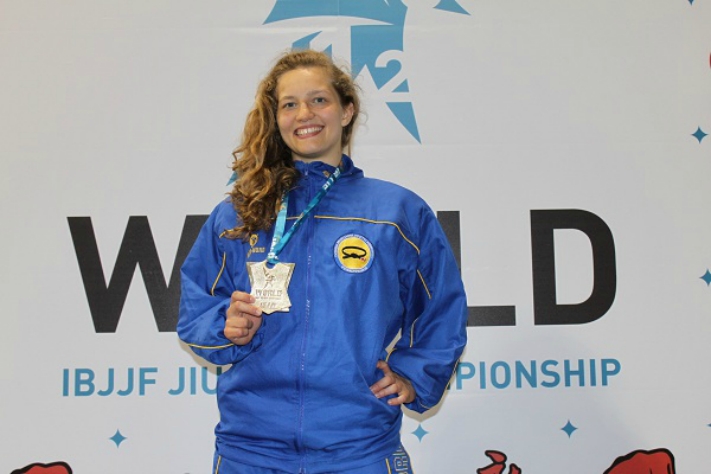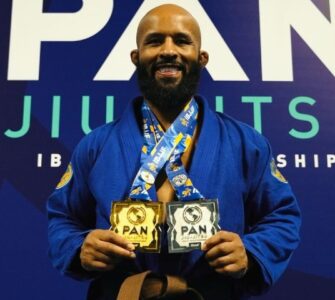Janni Larsson is the 2014 IBJJF world black belt champion and is also a 27 year old med-student living in Copenhagen, Denmark. She is Swedish, but moved to Denmark about five years ago after getting accepted at University.
Janni trains under Shimon Mochizuki at the CheckMat academy Arte Suave in Copenhagen. In 2012 she started competing internationally and won a few major titles at the lower belts. She got her black belt about 18 months ago and since then has won Worlds and Europeans in the middle class division. She has also won Abu Dhabi pro in -72kg and gotten silver in the open weight at Abu Dhabi pro.
She talked to Brazilian website BJJ Forum about balancing medical studies and high level competition, differences between Japanese Ju Jitsu and BJJ, competing against men, her time spent in Brazil and more.
You started in Japanese Ju Jitsu and moved to BJJ. And you also compete in Judo Newaza tournaments. Which are the main similarities and differences between each other?
The rules of BJJ and JJIF-Newaza are very similar. The biggest differences are that Newaza gives two points for reversals, one point for side control, and points are given with the second warning instead of the third. They don’t really define the guard in the Newaza rules so there are some situations, which cause a lot of confusion. Some of the JJIF judges have little or no grappling experience, which can be quite evident when watching the fights. I have for example seen judges give reversals points when one fighter had the back mount, and the fighters –still with the back mount in place- turned from facing the mat to facing the ceiling. I have heard that they are working on bringing in judges with a BJJ background, which I think would be very good for the people competing in Newaza.
The ju-jutsu I started with in 2005, JJIF-fighting, is very different from BJJ. In JJIF-fighting, there is point fighting with kicks and punches, take downs and control grips or submissions on the ground. You don’t win after the submission, because you need a perfect technique in all three parts. On the ground, most of the JJIF-fighters try to get to side control or mount fast, since very little time is given on the ground.
What is harder? Winning the IBJJF Worlds at black belt or balancing your time between Med School and BJJ?
Winning at black belt is only possible for me if I manage to balance Med-school and training. So my win 2014 shows that I managed to balance my time, that semester. Competing in it self isn’t hard, if you walk onto the mat knowing that you’ve done everything you can to prepare.
I have noticed that it is getting harder to balance the time between university and BJJ. The first years of med-school was just studying and exams. Now I have to do hours corresponding to a full time job at the hospitals, study and do exams. During the clinical semesters the students are placed at different hospitals, sometimes as far as four hours from Copenhagen. If I hade been placed at a hospital four hours away from my academy my jiujitsu carrier would have been over, or at least on hold. The University of Copenhagen has been very helpful and understanding though. I have been given dispensation so I don’t have to travel further than an hour to reach my hospital.

2014 Worlds. Photo: Kinya Hashimoto
Talking about hard… tells us about that time you ended up competing against men in Germany!
It was at a JJIF-Newaza competition in 2013. The organizers thought I was a man so they signed me up in the male category. Then they called the only girl in my weight and told her she didn’t have a fight, so she didn’t show. At the competition we managed to convince the organizers to let me compete against the men instead. The guys in -70 kg were okay with me competing in their weight and I ended up winning three out of four fights.
It’s strange how the world works. It was a small competition in Germany, which I didn’t even manage to win, still it’s the achievement media has written the most about, and it is still pops up on discussion threads on the internet.
During 2012 and 2013 you spent a few months living, training and competing in Brazil. How was that experience? Did it had an impact on your BJJ level? And how was it living in such a different culture than you are used to?
My months in Brazil had a huge impact on my jiujitsu. I lived in Santos outside of Sao Paulo and trained under Cavaca at the CheckMat academy. It was during that time I learnt the x-guard and footlocks. I got to train a lot with Michelle Nicolini, who is my biggest female role model in jiujitsu. Even after spending so much time with her, I still get a little bit starstruck when I see her.
The training partners I had in Brazil were smaller than I am used to and had very playful jiujitsu, which made it easier to learn the techniques. I sometimes miss them a bit when I am choosing between my Viking-sized training partners in Copenhagen.
Brazil is very different from the Scandinavian countries Sweden and Denmark. We have free education and medical care, and there is a lot of focus on equality between different social classes. The contrast between the Scandinavian and Brazilian society is big when looking at education and med-care. I reacted very strongly the first time I saw a favela in Brazil. I still have a hard time grasping the social inequalities.
In Sweden we have a lot of focus on gender equality and a few years back gender-neutral words were added to the Swedish language. We have lots of fathers that go on paternity leave and even male doctors stay home with the kids. In Sweden the gender roles are quite blurry. I did get a bit caught off guard when I went to Brazil where the gender roles are clearly cut. I didn’t understand, especially not at the start, how to act in order to follow the Brazilian norms. The clear gender roles were probably the cultural difference that I had the hardest time to handle when I was in Brazil.
What really fascinates me with Brazil is how alive the country is. It amazes me that so many people can dance and it seems like the people are more passionate than in Scandinavia. I love the beaches, the sun and the acai, and sometimes I just want to pause my life and return to Brazil.
The female Open Weight Class in the last years has been a little “predictable”, with Gabi Garcia winning all disputed tournaments. Do you think it is possible for the currently female competitors to beat her? How you’d see that happening? Which would be a smart strategy?
I think that Mackenzie Dern showed that it is quite possible to beat Gabi at Europeans this year, so I would say that taking Gabi’s back would be a good game plan. I am very impressed with both Mackenzie Dern and Beatriz Mesquita for fighting so well against Gabi, I am yet to survive longer than three minutes against her.
Read the entire interview (In Portuguese)…


















